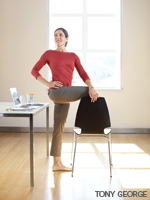Let’s face it: We’re a desk-potato nation. Some 80 percent of American jobs are sedentary, according to a study conducted earlier this year by the Pennington Biomedical Research Center at Louisiana State University in Baton Rouge, which conducts studies on physical activity, obesity, and aging.
But our bodies aren’t designed to hold a position for eight or more hours a day—they’re made to dance, twist, jump, and run. When we’re deskbound, the body has to hold a fixed, unnatural position for a long time. Eventually that can lead to problems, including changes in our metabolism, decreased circulation in the legs, and compression in the spine and pelvis, which places extra pressure on the connective tissue and nerves. Chronically poor posture can also lead to neck and back pain, repetitive stress injuries, and even bulging disks and sciatica.
What’s the solution? Stand up, stretch, and breathe deeply at least once every 50 minutes. You’ll find a quick sequence on these pages and great “office yoga” video instruction at yogajournal.com/officeyoga. So, get up and out of your chair—your body will thank you.
Twist Out Tension: Standing Chair Twist

What It Does: Wrings out tension in the deep muscles of the spine.
How to: Place your right foot on the seat of a chair. Press your knee against the back of the chair. Firm your legs and belly to stabilize your lower back. Twist to the right and hold the back of the seat with your left hand. Place your right hand on your right hip. Inhale; lengthen the spine. Exhale; slowly turn the shoulders to the right, looking over your right shoulder. Progressively deepen the twist over 8 to 10 breaths and then repeat on the other side.
Stretch Your Sides: Standing Crescent

What It Does: Lengthens the torso while opening the chest, rib cage, and shoulders. Facilitates deeper breathing.
How to: While standing, hold on to the back of the chair with your right hand. Ground both legs firmly into the floor. Inhale as you lift your left arm up by your ear. Exhale, engage your abdominal muscles, and move your tailbone down. Inhale, lengthen your spine, and sidebend to the right. Move your left shoulder back, open your chest, and breathe into your left side for 4 to 6 breaths. Repeat on the right side.
Relax Your Neck and Shoulders: Standing Shoulder Opener

What It Does: Helps reduce neck and shoulder pain by encouraging proper alignment of the upper arm bones, shoulders, and head.
How to: While standing, clasp your hands behind your back or hold on to a scarf or belt behind your back with your palms facing forward. Inhale; expand your torso. Exhale; firm the legs and belly. Inhale and slowly stretch your arms straight. Move your hands away from your back, draw the shoulders and head back, and enjoy the stretch across the collarbones. Exhale; lift the chin slightly and soften your jaw. Hold for 2 breaths, keeping your belly firm to support your low back while breathing deeply into your neck and shoulders.
Stretch Your Hips and Legs: Chair Warrior

What It Does: Stretches tight hips and leg muscles. Because the body is partially supported by the chair, you don’t need to exert as much energy to stay balanced in the pose, so you can focus on the stretch itself.
How to Sit: Sideways on a chair with your right knee bent to a 90-degree angle and your left leg extended straight behind you. Firm your legs, tone your belly, and lengthen the tailbone. Place your hands on your front thigh and breathe evenly into your torso while moving the shoulders and head back. Inhale and lift your left arm up, stretching your entire left side. Hold for 6 to 8 breaths and repeat on the other side.
From: Yoga Journal

